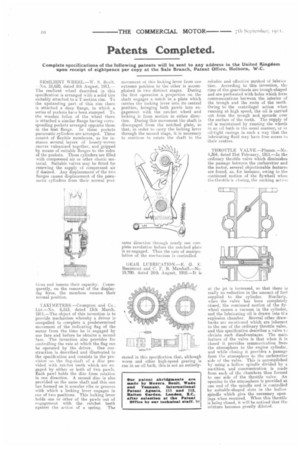Patents Completed.
Page 20

If you've noticed an error in this article please click here to report it so we can fix it.
Complete specifications of the following patents will be sent to any address in the United Kingdom upon receipt of eightpence per copy at the Sale Branch, Patent Office, Holborn, W.C.
RESILIENT WHEEL—W. S. Boult. -No. 18,620, dated 8th August, 1911,-The resilient wheel described in this specification is arranged with a solid tire suitably attached to a T-section rim. To the upstanding part of this rim there is attached a deep flange, in which a series of pockets have been stamped. To the wooden felloe of the wheel there is attached a similar flange having corresponding pockets arranged opposite those in the first flange. In these pockets pneumatic cylinders are arranged. These consist of flexible membrane, as for instance several lavers of loosely-woven canvas vulcanized' together, and gripped by means of suitable flanges to the sides of the pockets. These cylinders are filled with compressed air or other elastic material. Suitable valves may be fitted for renewing the supply of compressed air if desired. Any displacement of the two flanges causes displacement of the pneumatic cylinders from their normal posi
tines and lessens their capacity. Consequently, on the removal of the displacing force, the members resume their normal position.
T AXI M ETERS .—C rompton and Co., Ltd.—No. 6,513, dated 15th March, 191L—The object of this invention is to provide mechanism whereby a driver is compelled to complete a predetermined movement of the indicating flag of the meter from the time he is engaged by one fare and before he obtains a second fare. The invention also provides for controlling the rate at which the flag can be operated by the driver. One construction is described and illustrated in the specification and consists in the provision on the flag-shaft of a disc provided with ratchet teeth which. are engaged by either or both of two pawls. Each pawl holds the disc from rotation in one direction. A second disc is also provided on the same shaft and this one has formed on it annular ribs or grooves with which a locking lever engages in one of two positions. This locking lever holds one or other of the uawls out of engagement with the ratchet teeth against the action of a spring. The movement of this locking lever from one extreme position to the other is accomplished in two distinct stages. During the first operation a projection on the shaft engages a notch in a plate which carries the locking lever into its central position, bringing both pawls into engagement with the ratchet wheel and locking it from motion in either direction. During this movement the shaft is disengaged from the notched plate, so that, irt order to carry the locking lever through the second stage, it is necessary to continue to rotate the shaft in the same direction through nearly one complete revolution before the notched plate is re-engaged. Thus the rate of manipulation of the mechanism is controlled.
GEAR LUBRICATION.—E. G. E. Beaumont and C. F. B. Marshall.—No. 19,780, dated 24th August, 1910.—It is
stated in this specification that, although worm and other high-speed gearing is run in an oil bath, this is not art entirely
reliable and effective method of lubrica. tion. According to this invention, the rims of the gearwheels are trough-shaped and are perforated with holes which form communications between the interior of the trough and the roots of the teeth. Owing to the centrifugal action when running at high speed, the oil is carried out from the trough and spreads over the surface of the teeth. The supply of oil is maintained by running the wheels in an oil bath in the usual manner, or in oil-tight casings in such a way that the lubricating fluid may have free access to their centres.
THROTTLE VALVE.—Plumm.—No. 4,364, dated 21st February, 1911.—In the ordinary throttle valve which diminishes the passage between the carburetter and the motor, several objectionable feature3 are found, as, for instance, owing to the continued motion of the flywheel when the throttle is closing, the sucking action
at the jet is increased, so that there is really no reduction in the amount of fuel. supplied to the cylinder. Similarly, when the valve has been completely cloeed, the continued motion of the flywheel causes a vacuum in the cylinder, and the lubricating oil is drawn into the explosion chamber. Several other drawbacks are mentioned which are inherent to the use of the ordinary throttle valve, and this specification describes a valve ti obviate such disadvantages. The main feature of the valve is that when it is closed it provides communication from the atmosphere to the engine cylinder, and while closing it provides a passage from the atmosphere to the carburetter side. of the valve. This is accomplished by using a hollow spindle divided by a partition, and communication is made from each of the chambers thus formed to one side of the throttle valve. An opening to the atmosphere is provided at one end of the spindle and is controlled. by suitably-shaped slots in the hollow spindle which give the necessary openings when reauired. When this throttle is being closed, it will be noticed that themixture becomes greatly diluted.




















